The New Town of Edinburgh - James Craig’s map
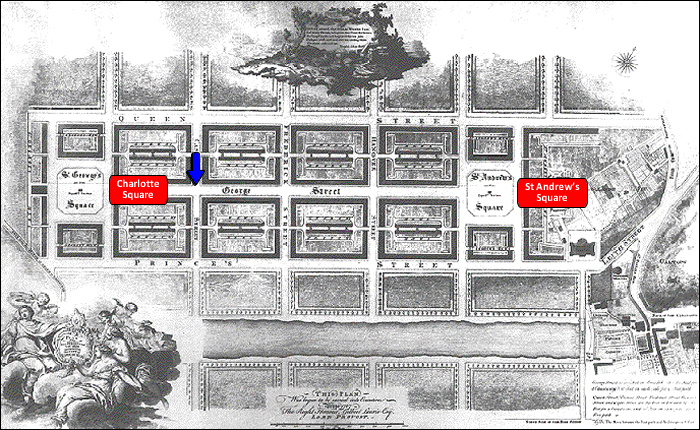
- Castle Street in Edinburgh ,
- Charlotte Square in Edinburgh ,
- Charlotte Square in Edinburgh ,
- St Andrew's Square in Edinburgh ,
- St Andrew's Square in Edinburgh , )
At the end of the 18th century, Edinburgh had become one of the most visited and celebrated European towns, as the author of an anonymous manuscript ’Nine Months in Scotland, 1795-1796 ’ was pleased to point out :
“Edinburgh by its late improvements has justly obtaine’d a place among the most celebrated cities of Europe and there are few capitals, in which any part can be shewn, that in beauty and regularity of plan, in stately Buildings, and in Pleasant Situation, can compare with that part of Edinburgh which is named the New Town.”
National Library of Scotland MS. 16. 2. 15, 51-52
It is to James Craig (1740-1795) that Edinburgh owed its new fame and renewed prestige. This young 26 year old architect had taken up, like certain of his fellow architects, an invitation to tender launched by the town in March 1766. His plan, bearing the number 4, was judged the best out of the six by the Mayor and by the consultant architect John Adam in 1766. No one knows exactly what happened between this date and July 1767, when Craig’s plan was finally adopted definitively. The modifications made to the initial plan, notably the name changes of certain streets, are not enough to explain the slowness of the councillors’ decision; Forth Street became Queen Street and St. Giles Street was named Princes Street following a suggestion by George III himself to whom Craig dedicated his plan. The fact that Craig addressed his plan to the King, without adding to the royal name the name of certain personalities of Edinburgh, explains perhaps the problems he had before his plan was definitively accepted. It is not improbable that persons of note may have held this awkward omission against him.
The New Town, which is an evidence of the new geometrical approach to town-planning, has a chequerboard plan, with a main West-East axis lined with houses on both sides (George Street) leading from a square at its West end (Charlotte Square, formerly St George ’s Square) to its counterpart at the East end (St Andrew’s Square). The West-East thoroughfares parallel to George Street, to the South (Princes Street) and to the North (Queen Street), both open on to gardens towards their outer side. They are crossed by North-South perpendicular streets. The New Town is linked to the Old Town by gardens and by a bridge.
Craig’s plan had the good fortune to satisfy the aesthetic tastes of Edinburgh’s middle-classes and aristocracy, and to remove the last hesitations of a great many townspeople, who remained attached to ’Auld Reekie’ (Edinburgh’s former nickname - Scottish for ’Old Smoky’) despite the attraction of the New Town. The more well-to-do families, once their decision to emigrate had been taken, did not hesitate to call in famous architects to build their future residence. In this way the very handsome residence of Sir Laurence Dundas, at 36 Saint Andrew’s Square (now the Royal Bank of Scotland) was the work of King George III’s architect, Sir William Chambers (1726-1796), recognised as being Robert Adam’s (1728-1792) only serious rival. St Andrew’s Square became one of the most residential areas of the New Town, and also one of the most admired by visitors, amongst others by the traveller Henry Skrine, author of Three Successive Tours in the North of England to the Lakes and Great Part of Scotland (London, 1813): “We were most agreeably surprised to find ourselves transported in the most regular and superb city that any country can boast. The streets all intersect each other at right angles, and the buildings are of the finest stone, constructed in the most perfect uniformity. St Andrew’s Square would vie with most of the London squares in extent, exceed them in regularity. George Street, 115 feet wide, and of a vast length, leads into the centre of this square.” (65).
Views from various streets
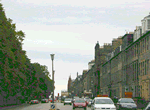
- Queen Street
- View of Princes Street towards the West (Charlotte Sq)
[click on the picture to enlarge it]
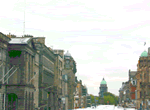
- George Street
- View of George St towards the West (Charlotte Sq, with St George’s Church)
[click on the picture to enlarge it]
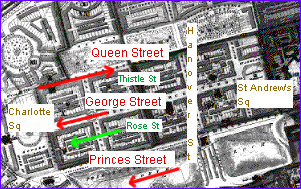
- The New Town of Edinburgh
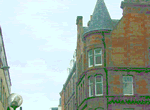
- Rose Street
- View of Rose St towards the West
[click on the picture to enlarge it]
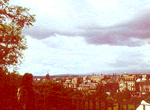
- Princes Street
- View of Princes Street towards the West (Charlotte Sq)
[click on the picture to enlarge it]
The views show the contrast between George Street, which is lined with houses on both sides, and Queen Street or Princes Street, which have a garden on the external side.
Rose Street is a smaller backstreet.

